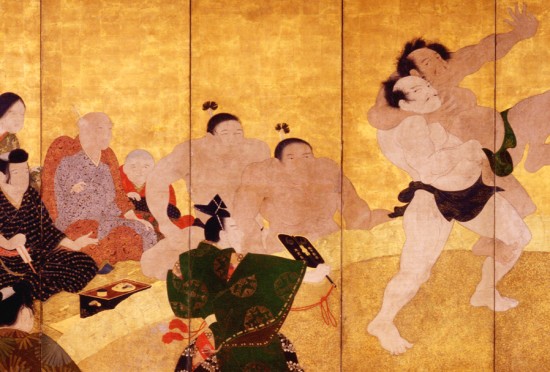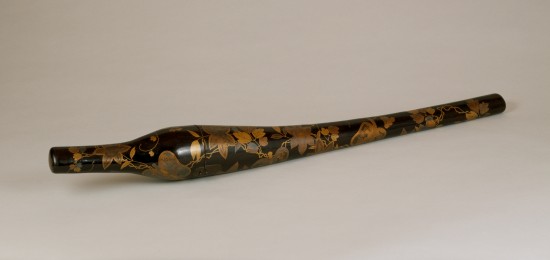From Hara Museum ARC, Gunma Prefecture
This is the second part of the current exhibition at the Kankai Pavilion, which continues the celebration of autumn by presenting various paintings depicting seasonal landscapes and stories that express the people’s aesthetic sensibilities and their relationship with nature. We hope such scenes will inspire a renewed appreciation of the nature that still exists near us.

Sumo match, pair of six-fold screens (left-hand screen)
The first work of interest in Part II is a lively depiction of a sumo match painted on a gold ground.
The history of the sport is ancient, its origin being recorded in the annals of the Kojiki and Nihon Shoki. Depictions of sumo wrestlers can also be seen in clay haniwa figurines from the Kofun period.
The association of the word “sumo” with the season arose during the Nara and Heian periods from the custom of the imperial court to hold sumo matches every year in the early autumn (i.e., the seventh month of the lunar calendar). This annual rite, called “Tenranzumo,” was carried out as a prayer for the nation’s well-being and a bountiful rice crop. For this reason, even to this day, sumo matches are held at autumn festivals in various regions of Japan.
In this folding screen with its gold ground, we see competing sumo wrestlers at an outdoor sumo ring and the spectators watching them. Wrestler A has grabbed wrestler B’s belt and is lifting him off the ground. Both of wrestler B’s legs are dangling in the air, one coiled around his opponent’s calf, his right arm wrapped around his opponent’s neck. Both are desperately fighting to stay in the ring. The painting is distinguished by the use of gorgeous colors and detailed brushwork, with the kimonos and hairstyles of the spectators being shown in great detail, giving life to the fashion of the early Edo period.
Another must-see item is the Case of a sword decorated with clematis and war fan pattern, a carrying case for a sword, upon which are drawn fans of the like used by military leaders.

Case of a sword decorated with clematis and war fan pattern in maki-e
Highlights
Traditional Art
Book of model handwriting, called “Reiso-dai,” attributed to Prince Shotoku and others, Nara-Muromachi period/ Kano Eitoku, Tiger in a bamboo grove, (originally part of works painted on wall paper and sliding doors at Nikko-in Mi’idera temple), hanging scroll, Momoyama period/ Kano School, Wild horses and horsemen (originally part of works painted on wall paper and sliding doors at Nikko-in Mi’idera temple), four hanging scrolls, Momoyama-Edo period/ Sumo match, pair of six-fold screens, Edo period/ Case of a sword decorated with clematis and war fan pattern in maki-e, Edo period/ Tier of boxes decorated with design of squirrels in vine scrolls in maki-e, Edo-Meiji period
Contemporary Art
Jae-Eun Choi, Homage to Mozart, 1991/ Anish Kapoor, Void, 1992/ Toko Shinohara, Inishie, 2003/ Noe Aoki, Tateyama, 2007/ Hiroe Saeki, Untitled, 2009
Fall exhibition at Hara Museum ARC
◆Kankai Pavilion
The Colors of Autumn
Dates: October 16 (Sat.) – December 5(Sun.), 2010
*Kankai Pavilion will be closed from Nobember 24 to 27. The show has been extended.
◆Contemporary Art Galleries
Cheer up! Art can make you happy—Selections from the Hara Museum Collection
Dates: September 11 (Sat.) – December 5 (Sun.), 2010
